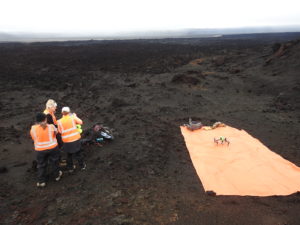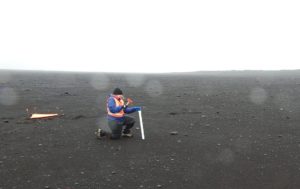15 January 2020
Nearly barren Icelandic landscapes guide search for extraterrestrial life
Posted by Lauren Lipuma
Scientists attempt to refine planetary rover survey strategies by studying Earth habitats similar to Mars
By Kate S. Petersen

FELDSPAR 2019 team discussing a plan for drone mapping at the Holuhraun volcanic eruption site. Pictured (right to left): Anna Simpson, Carlie Novak, and Amanda Stockton of Georgia Institute of Technology.
Credit: Erika Rader.
New research on microbial lifeforms living in nearly barren volcanic landscapes in Iceland may help scientists understand how best to search for life on other planets.
Researchers with NASA’s FELDSPAR (Field Exploration and Life Detection Sampling for Planetary Analogue Research) project are studying the distribution of life in these harsh Icelandic environments to inform the search for hidden life signs on planets like Mars. So far, they have found that microbes at their study sites are often isolated in “hot spots” and that microbial communities are distributed differently in areas subjected to different geological resurfacing processes, such as wind or glaciation. They presented their results last month at AGU’s Fall Meeting 2019 in San Francisco.
The search for extraterrestrial life is currently limited to remote sensing, with satellites and telescopes, and ground-based robotic missions, such as NASA’s Mars 2020 rover mission set to launch next year. Rovers can only collect and test a certain number of samples before their resources are exhausted, so sample selection must be strategic.
Scientists suspect Mars was once warmer and wetter than it is now and could have harbored life. However, signs of past life or potential surviving lifeforms are not obvious. “What [FELDSPAR researchers] have been working on is trying to figure out how many samples we need to get in order to probabilistically sample that one region that has that biological hotspot,” said Amanda Stockton, a biochemist at Georgia Institute of Technology and co-principal investigator of the FELDSPAR project.
It is the lack of widespread, obvious life that makes Icelandic volcanic environments an ideal choice as Martian analog sites. They are covered in tephra, ash or rocky material spewed from the volcanos. The tephra is dominated by basalt, a volcanic rock that makes up many regions on the surface of Mars. FELDSPAR researchers collect tephra samples and test them for DNA and ATP, a biomolecule that terrestrial life uses to transfer energy. While the researchers are analyzing signs of contemporary (extant) life in Iceland, they say that understanding these distribution patterns may also be useful for searching for biological signatures of extinct life on other planets.
Jen Blank, who leads the NASA BRAILLE project to characterize signs of life in lava tubes and is not involved in FELDSPAR, praised the research. “It’s the first really systematic study on different scales that’s been done, because it’s so hard to do. And it takes a lot of time,” she said.
Unfortunately, if these Icelandic analog sites are any indication, it could potentially take more samples than a rover could analyze to locate life signs on another planet, even if they are present, according to the researchers. Stockton described one area where the team analyzed nearly 400 samples and only two had high levels of biology.
Given this reality, FELDSPAR researchers are attempting to refine search parameters by investigating whether there are any physical features in the environment that are correlated with pockets of life. If so, remote sensing technology from satellites or drones could be used to identify places that are most likely to harbor signs of life before a rover uses precious resources to actually analyze samples.
This work is still in process, but the researchers have made some preliminary findings. According to FELDSPAR researcher Anna Simpson, a microbial ecologist at Georgia Institute of Technology, one potential environmental factor that could impact the distribution of life is the geological history of the area. “Life occurs in patches and along gradients in areas shaped by wind, while it is evenly distributed with a few seemingly random hotspots of high biological activity in areas impacted by recent glaciation,” she said.
Simpson said the team has also begun evaluating average tephra grain size at a site as another potential predictive factor for biosignatures on Mars. “We’re really interested in whether the number of crevices in a mineral grain is going to affect how much life is there,” Simpson said. She explained that larger grains with more crevices could potentially shelter microbes from lethal UV radiation at the surface of Mars. “We actually do find that, where there’s really big chunks of basalt in the tephra, those tend to have more ATP,” said Simpson, who emphasized that more analysis was needed to confirm this pattern.
The FELDSPAR researchers are still analyzing data from their last field season and plan to publish more results that may inform rover search techniques in the future. But it is already very clear that constraints on life and how it is distributed in space and time can differ depending on the environment, said Diana Gentry, a co-principle investigator on FELDSPAR and a microbiologist who specializes in instrumentation at NASA Ames Research Center. “That has [implications] for the assumptions you make about life on other worlds and…how you would go looking for it.”
Kate S. Petersen is a current student in the MIT Graduate Program in Science Writing.











 GeoSpace is a blog on Earth and space science, managed by AGU’s Public Information staff. The blog features posts by AGU writers and guest contributors on all sorts of relevant science topics, but with a focus on new research and geo and space sciences-related stories that are currently in the news.
GeoSpace is a blog on Earth and space science, managed by AGU’s Public Information staff. The blog features posts by AGU writers and guest contributors on all sorts of relevant science topics, but with a focus on new research and geo and space sciences-related stories that are currently in the news.